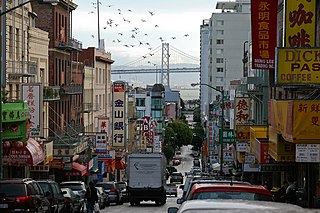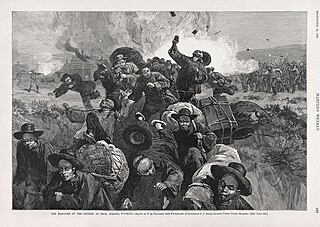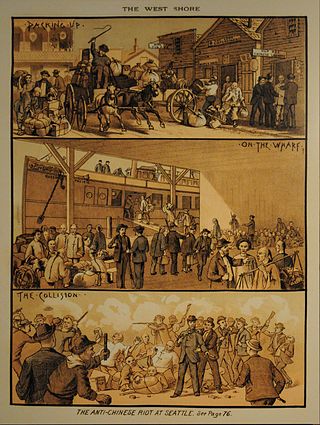In the broader context of racism against Black Americans and racism in the United States, mass racial violence in the United States consists of ethnic conflicts and race riots, along with such events as:

The Chinese Exclusion Act was a United States federal law signed by President Chester A. Arthur on May 6, 1882, prohibiting all immigration of Chinese laborers for 10 years. The law excluded merchants, teachers, students, travelers, and diplomats. Building on the earlier Page Act of 1875, which banned Chinese women from migrating to the United States, the Chinese Exclusion Act was the only law ever implemented to prevent all members of a specific ethnic or national group from immigrating to the United States.

The Chinatown centered on Grant Avenue and Stockton Street in San Francisco, California, is the oldest Chinatown in North America and one of the largest Chinese enclaves outside Asia. It is also the oldest and largest of the four notable Chinese enclaves within San Francisco. Since its establishment in 1848, it has been important and influential in the history and culture of ethnic Chinese immigrants in North America. Chinatown is an enclave that has retained its own customs, languages, places of worship, social clubs, and identity. There are two hospitals, several parks and squares, numerous churches, a post office, and other infrastructure. Recent immigrants, many of whom are elderly, opt to live in Chinatown because of the availability of affordable housing and their familiarity with the culture. San Francisco's Chinatown is also renowned as a major tourist attraction, drawing more visitors annually than the Golden Gate Bridge.

Aaron Augustus Sargent was an American journalist, lawyer, politician and diplomat. In 1878, Sargent historically introduced what would later become the 19th Amendment to the U.S. Constitution, giving women the right to vote. He was sometimes called the "Senator for the Southern Pacific Railroad".
The Asiatic Exclusion League was an organization formed in the early 20th century in the United States and Canada that aimed to prevent immigration of people of Asian origin.
Yick Wo v. Hopkins, 118 U.S. 356 (1886), was the first case where the United States Supreme Court ruled that a law that is race-neutral on its face, but is administered in a prejudicial manner, is an infringement of the Equal Protection Clause in the Fourteenth Amendment to the U.S. Constitution.

Chinese American Citizens Alliance (C.A.C.A.) is a Chinese American fraternal, benevolent non-profit organization founded in 1895 in San Francisco, California to secure equal rights for Americans of Chinese ancestry and to better the welfare of their communities. C.A.C.A. is the United States' oldest Asian American civil rights organization.

The Rock Springs massacre, also known as the Rock Springs riot, occurred on September 2, 1885, in the present-day United States city of Rock Springs in Sweetwater County, Wyoming. The riot, and resulting massacre of immigrant Chinese miners by white immigrant miners, was the result of racial prejudice toward the Chinese miners, who were perceived to be taking jobs from the white miners. The Union Pacific Coal Department found it economically beneficial to give preference in hiring to Chinese miners, who were willing to work for lower wages than their white counterparts, angering the white miners. When the rioting ended, at least 28 Chinese miners were dead and 15 were injured. Rioters burned 78 Chinese homes, resulting in approximately US$150,000 in property damage.
The Tacoma riot of 1885, also known as the 1885 Chinese expulsion from Tacoma, involved the forceful expulsion of the Chinese population from Tacoma, Washington Territory, on November 3, 1885. City leaders had earlier proposed a November 1 deadline for the Chinese population to leave the city. On November 3, 1885, a mob that consisted of prominent businessmen, police, and political leaders descended on the Chinese community. The mob marched Chinese residents to a railroad station and forced them to board a train to Portland. In the following days, the structures that remained in the Chinese community were razed. The event was the result of growing anti-Chinese sentiment and violence throughout the American West.

The Seattle riot of 1886 occurred on February 6–9, 1886, in Seattle, Washington, amidst rising anti-Chinese sentiment caused by intense labor competition and in the context of an ongoing struggle between labor and capital in the Western United States. The dispute arose when a mob affiliated with a local Knights of Labor chapter formed small committees to carry out a forcible expulsion of all Chinese from the city. Violence erupted between the Knights of Labor rioters and federal troops ordered in by President Grover Cleveland. The incident resulted in the removal of over 200 Chinese civilians from Seattle and left two militia men and three rioters seriously injured.
There were at least several incidents of anti-Chinese violence in Washington, a United States territory and later, a U.S. state, which occurred during the 19th, 20th and 21st century. In the 19th century, the Chinese Exclusion Act of 1882 created hostile attitudes towards the Chinese people residing in the U.S. The act sparked a wave of anti-Chinese riots and murders occurring in Washington, such as the Tacoma Riot of 1885, the Rock Springs massacre and the Hells Canyon massacre in 1887. There were riots and mob actions in Issaquah and Seattle which resulted in at least four people being killed and extensive property damage. Anti-Chinese violence continued throughout the 20th and 21st centuries, particularly in the wake of the COVID-19 pandemic.

The Scott Act was a United States law that prohibited U.S. resident Chinese laborers from returning to the United States. Its main author was William Lawrence Scott of Pennsylvania, and it was signed into law by U.S. President Grover Cleveland on October 1, 1888. It was introduced to expand upon the Chinese Exclusion Act passed in 1882 and left an estimated 20,000-30,000 Chinese outside the United States at the time of its passage stranded, with no option to return to their U.S. residence.

Chinatowns are enclaves of Chinese people outside of China. The first Chinatown in the United States was San Francisco's Chinatown in 1848, and many other Chinatowns were established in the 19th century by the Chinese diaspora on the West Coast. By 1875, Chinatowns had emerged in eastern cities such as New York City, Boston, and Philadelphia. The Chinese Exclusion Act of 1882 barred Chinese immigration to the United States, but the Magnuson Act of 1943 repealed it, and the population of Chinatowns began to rise again. In the 2010s, the downturn in the U.S. economy caused many Chinese Americans to return to China.

The San Francisco riot of 1877 was a three-day pogrom waged against Chinese immigrants in San Francisco, California by the city's majority white population from the evening of July 23 through the night of July 25, 1877. The ethnic violence which swept Chinatown resulted in four deaths and the destruction of more than $100,000 worth of property belonging to the city's Chinese immigrant population.
The U.S. city of Tacoma, Washington was once home to a significant historic Chinatown. It was located in Downtown Tacoma near Railroad Street according to a historical record.

Frederick Alonzo Bee (傅列秘) was an early opponent of Anti-Chinese sentiment in the United States. He was a California Gold Rush pioneer, miner, merchant, manager of the Pony Express, builder of the telegraph over the Sierras, developer of Sausalito, California, lobbyist for the San Francisco Chamber of Commerce, official at the Chinese Consulate, and vineyardist near Martinez, California. Bee Street in Sausalito was named after him. Bee was appointed as Consul by the Chinese government after he effectively represented the interests of the Chinese community in front of a Congressional committee and settled disputes in Chinatown. Bee acted in an official capacity to represent the interests of Chinese immigrants, and appeared in federal court cases; his efforts to preserve harmony were recognized by the Emperor of China. October, 2015 Sierra Heritage magazine featured Frederick Bee in a 4-page article written by Lj Bottjer. Sherri Bergmann wrote an article for the January 22, 2018 Mountain Democrat.

Greater Seattle has had a Chinese American community almost since its founding in 1851. Chinese workers arriving in the 1860s were welcomed, because the Seattle area was sparsely settled and workers were needed; within a few decades, however, newly arrived white settlers resented the Chinese workers, and there were several anti-Chinese riots as the whites attempted to expel the Chinese from the area. Chinese settlement persisted, with the immigrants settling in a well-defined Chinatown where they maintained their culture through family groups, associations, and churches. In the mid-20th century Chinese Americans joined with other immigrant groups to oppose racial discrimination. In 1962 a Chinese American became the first person of Asian ancestry to hold elective office in the state of Washington.
Chinese Americans in the Pacific Northwest have been around since as early as the 1850s. Chinese Americans arrived in the Greater Seattle area in as early as 1851. Oregon had also seen an influx of Chinese Immigrants as early as 1851, because of mining opportunities. Idaho saw an influx of Chinese Immigrants in the late-19th century, and by 1870 saw a population of around 4,000 Chinese immigrants. The influx of Chinese immigrants in the Pacific Northwest and the rest of the Western United States led to retaliation by whites, leading to anti-Chinese sentiment in the United States. These sentiment then led to the Chinese Exclusion Act of 1882, which expelled many Chinese Americans in the Pacific Northwest. Chinese exclusion is also driven by the failure of restriction. The United States had passed the Chinese Exclusion Act of 1882 to slow immigration, and mend Sinophobia in the west. However, the enforcement of the exclusion act was lackluster. The United States Department of Treasury had found itself with no money to enforce this law. Thus, nullifying the purpose of the exclusion act. Additionally, under the Chinese Exclusion Act of 1882, Chinese people could migrate to the United States if they were return immigrants. Consequently, Chinese immigrants began claiming that they were return immigrants so that they could work in the United States. This also made the Chinese Exclusion Act 1882 useless. This led the United States government to pass the Scott Act of 1888. This excluded all Chinese immigration because it was cheaper, and it appeased the racial tensions in the west.
Anti-Chinese violence in California includes a number of massacres, riots, expulsions and other violent actions that were directed at Chinese-American communities during the mid and late 19th century. The attacks on Chinese were often sparked by labor disputes. In the 1880s alone, Chinese communities were attacked in 34 towns in California, often resulting in the local Chinatown being looted and burned.

The George Dee Magic Washing Machine Company commissioned Uncle Sam Kicks Out The Chinaman in 1886. Published in Chicago by Shober & Carqueville Lithograph Co. the cartoon depicts patriotic symbol Uncle Sam kicking out the Chinese in order to promote The George Dee Magic Washing Machine Company's new detergent in an effort to displace Chinese laundry operators. Above the borders of the image an advertisement in the lithograph reads:
To Whom It May Concern: This is a Liquid Washing Compound, and is FULLY GUARANTEED BETTER THAN ANYTHING EVER OFFERED TO THE PUBLIC; its constant use will not injure the cloths nor turn them yellow. For sale by the Gallon, Half-Gallon and Quart. TRY A SAMPLE AND BE SURPRISED.













